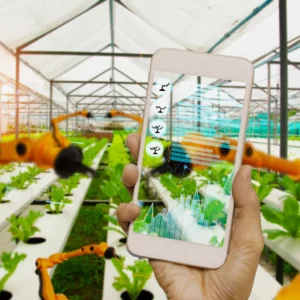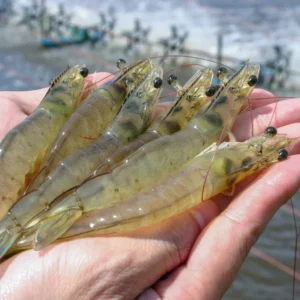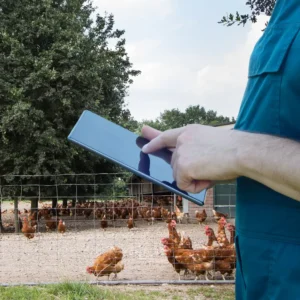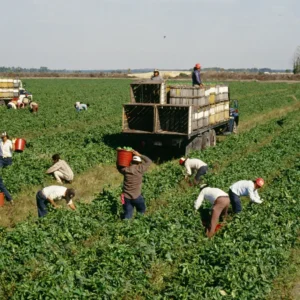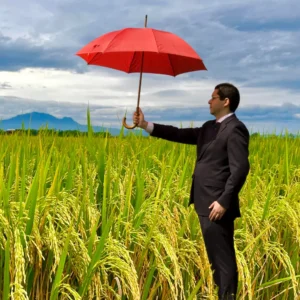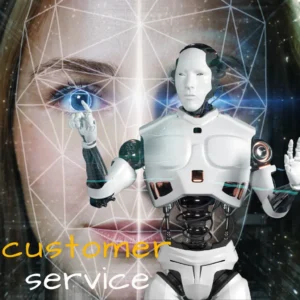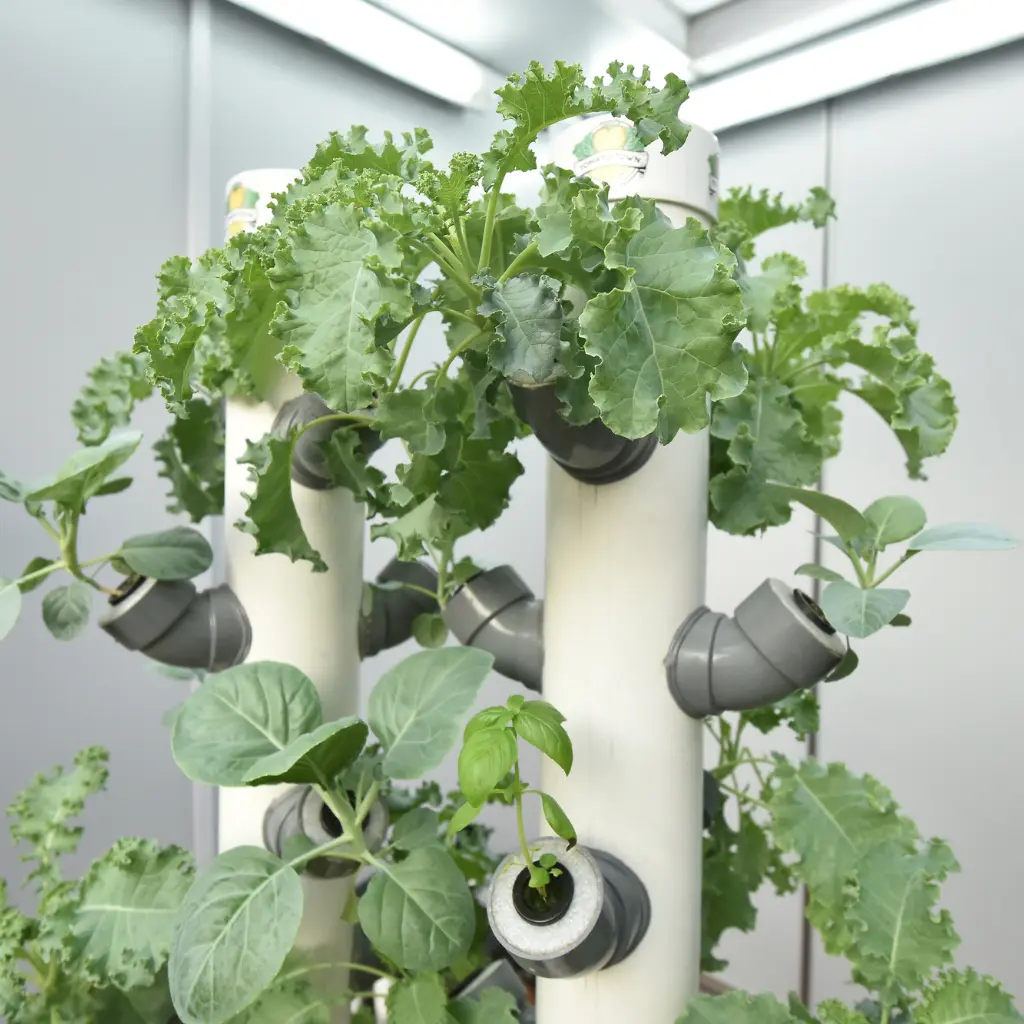
Cultivating Cities
The AI Urban Farming Revolution
A quiet revolution is unfolding in the heart of bustling cities – the AI Urban Farming Revolution. Picture skyscrapers adorned with vertical farms, rooftops transformed into lush gardens, and urban green spaces teeming with life.
This revolution is more than just innovation; it reimagines how we cultivate food in the urban jungle.
The AI Urban Farming Revolution introduces many transformative technologies, each vital in reshaping our urban landscapes. From predicting crop success to optimizing every inch of urban farming space, AI-driven solutions empower city farmers like never before.
In this article, we journey through various facets of this revolution. We’ll explore how AI makes city farming more innovative, efficient, and accessible. Discover how AI chatbots, smart irrigation, real-time monitoring, and predictive analytics work together to create a greener, more sustainable future for our cities.
Table of Contents
Going Vertical: AI in Multi-Layered Farms
Amid the AI Urban Farming Revolution, vertical farming is a shining example of innovation. AI in vertical farming optimization has enabled growers to maximize their yield, growing crops in multiple stacked layers. Picture towering structures, bustling with life, where every inch is precious, and AI is the guiding force.
Thanks to ML for urban crop predictions, these vertical farms anticipate the needs of their crops with astounding accuracy. No more guesswork – AI crunches the data and ensures that every seed sown has the potential to flourish.
AI-driven urban irrigation systems are the heart of these farms. They delicately shower each plant with just the right amount of water, conserving resources in compact spaces. This technological marvel epitomizes efficiency.
In these multi-layered farms, analytics in city farming efficiency play a crucial role. AI analyzes every aspect of the cultivation process, from temperature to nutrient levels, constantly fine-tuning to perfection.
Imagine AI and rooftop gardening joining forces, creating urban oases atop skyscrapers. AI’s guidance brings these green spaces to life, producing food where you’d least expect it.
As we delve deeper into the AI Urban Farming Revolution, let’s explore how technology helps us keep an AI eye on city green spots, ensuring urban farms thrive even amid concrete jungles. How do these AI-driven farms communicate with urban growers? AI chatbots for city farmers provide advice and guidance in real time.
But what’s next? How do we anticipate the urban harvests and ensure that the AI Urban Farming Revolution continues flourishing? Stay tuned to discover the magic of Predicting city crop success and how AI is shaping the future of urban agriculture.
Predicting City Crop Success
Having unveiled the wonders of AI in multi-layered farms, it’s time to explore the next frontier in the AI Urban Farming Revolution – predicting city crop success. With AI’s prowess, farmers can now gaze into the future of their harvests.
Imagine a world where we can harness the power of predictive analytics for urban yield. We can forecast crop performance with precision thanks to AI, avoiding potential setbacks.
The success stories of AI in urban agriculture are inspiring. Through real-time monitoring of urban gardens, AI detects anomalies and threats, ensuring the well-being of crops. It’s like having a vigilant guardian for every plant.
But what’s the secret behind this predictive magic? How does AI accurately foresee the outcomes of urban farming? The answer lies in the vast dataset it analyzes, incorporating AI and rooftop gardening data, AI-driven urban irrigation systems statistics, and even insights from AI chatbots for city farmers.
With AI’s predictive abilities, city farmers can plan, adapt, and optimize their farming techniques, ensuring a thriving urban harvest. However, as we peer into the future of urban agriculture, we must ask: How can AI further enhance efficiency in resource utilization? The answer awaits in the next topic, “Smart irrigation in compact spaces.”
Smart Irrigation in Compact Spaces
As we dive deeper into the wonders of the AI Urban Farming Revolution, we explore the critical role of intelligent irrigation, a cornerstone for urban crop success. But how does it work in those tight city spaces we’ve discussed?
Building upon our understanding of predicting city crop success, we see that intelligent irrigation is the key to making those predictions come true. With its real-time monitoring, AI ensures that every drop counts, especially in multi-layered farms and rooftop gardens where space is at a premium.
Imagine irrigation systems that respond to current weather conditions and factor in historical data, thanks to ML for urban crop predictions. These systems can determine the required moisture levels, avoiding overwatering or under-nourishing the crops.
In this tightly woven tapestry of technology, analytics in city farming efficiency play a crucial role. AI analyzes soil conditions, weather forecasts, and even nutrient levels to make intelligent decisions about irrigation, ensuring optimal growth in AI-driven urban irrigation systems.
But what’s the next step in this relentless pursuit of efficiency? How do we make the most of every inch of urban farming space? Join us in our quest to unravel the mysteries of “Optimizing every urban farming inch.”
Optimizing Every Urban Farming Inch
Building on our journey through the AI Urban Farming Revolution, we now focus on a pivotal aspect: optimizing the use of every inch of urban farming space. But what strategies and innovations are at play to achieve this?
Following our exploration of smart irrigation in compact spaces, the focus shifts to harnessing the full potential of limited urban farming real estate. AI in vertical farming optimization has emerged as a game-changer, allowing multiple layers of crops to thrive in a single footprint. This revolutionary approach makes the most of space, like a vertical dance of greens.
In addition, implementing real-time monitoring for urban gardens guarantees that every corner is observed. I have also ensured no spelling, grammar or punctuation errors in the text. AI continuously assesses crop health, making instant adjustments and maximizing yields.
In these tightly packed urban environments, analytics in city farming efficiency again come to the forefront. AI analyzes data on plant growth patterns, resource utilization, and more, offering insights that lead to intelligent decisions.
But what about the rooftops? How can we elevate these barren spaces into thriving green oases? Join us in our next topic, “Elevating rooftop gardens with AI,” to uncover the possibilities for transforming urban rooftops into lush gardens.
Elevating Rooftop Gardens with AI
Continuing our exploration of the AI Urban Farming Revolution, we ascend to new heights – urban rooftops. How can AI transform these often-overlooked spaces into thriving gardens that beautify and feed our cities?
Having pondered the art of optimizing every urban farming inch, we look skyward for answers. Rooftop gardens, once barren and untapped, are now buzzing with life thanks to AI. Imagine a cityscape with lush oases atop buildings, producing fresh, sustainable food.
AI and rooftop gardening go hand in hand, ensuring that greenery can flourish even in the most confined spaces. AI optimizes plant placement, sunlight exposure, and irrigation to maximize these elevated plots.
The secret sauce lies in real-time monitoring of urban gardens. AI keeps a vigilant eye on rooftop crops, swiftly detecting issues and orchestrating solutions. It’s like having a guardian angel for your garden in the sky.
But what other possibilities does the marriage of AI and rooftop gardens hold? How can these green spaces benefit our cities even further? Join us in our next topic, “Keeping an AI eye on city green spots,” to unveil the broader vision for AI’s role in urban agriculture.
Keeping an AI Eye on City Green Spots
From the heights of rooftop gardens, our journey in the AI Urban Farming Revolution now lands on the urban ground, where green spaces thrive. But how does AI continue to nurture these precious city green spots?
Having explored the potential of AI and rooftop gardening, we descend into the heart of our cities. AI’s role is not limited to vertical and rooftop farming; it extends to every green corner. In real-time, AI-powered sensors and cameras monitor these urban gardens, parks, and community plots.
AI chatbots for city farmers are the watchful sentinels. They provide immediate insights, answer questions, and advise novice and seasoned urban growers. Imagine having a virtual farming companion at your fingertips, ready to guide you through every stage.
This real-time surveillance ensures that our city’s green spots remain vibrant and healthy. From community gardens to public parks, AI ensures that they flourish. But what more can AI bring to the world of urban agriculture? Join us in our next topic, “Urban farming advice via chatbots,” to uncover the possibilities of AI-driven guidance for city farmers.
Urban Farming Advice via Chatbots
Transitioning from the watchful gaze of AI on city green spots, we dive deeper into the heart of the AI Urban Farming Revolution. With AI technology at our fingertips, how can we enhance the guidance and support for city farmers?
Building upon the idea of keeping an AI eye on city green spots, we focus on personalized assistance. AI chatbots for city farmers are friendly, 24/7 companions that offer real-time advice, answer queries and provide insights.
Imagine a novice urban gardener wondering about the right time to harvest their tomatoes or a seasoned farmer seeking guidance on pest control. AI chatbots step in with instant, tailored responses, ensuring urban farmers make the most of their crops.
These chatbots have access to a wealth of data, incorporating insights from predictive analytics for urban yield and the experiences of other city farmers. They enable growers to make informed decisions and foster community among urban agriculture enthusiasts.
But what’s next in this AI-driven revolution? How can we elevate urban farming even further? Join us in our next topic, “Anticipating urban harvests,” as we explore the exciting possibilities of foreseeing the outcomes of city farming with AI.
Anticipating Urban Harvests
Continuing our journey through the AI Urban Farming Revolution, we arrive at a pivotal point: the ability to anticipate urban harvests. But how does AI make this possible, and what implications does it have for city farming?
Drawing from urban farming advice via chatbots, where AI provides real-time support, we now delve into prediction. AI’s vast database of information, from predictive analytics for urban yield to historical crop data, empowers growers to foresee harvest outcomes.
Imagine knowing precisely when your ripest strawberries will be ready for picking or when your lettuce will reach its freshness. AI’s predictive capabilities enable precise planning, harvesting, and enjoyment of the fruits of labour.
Furthermore, AI’s predictive prowess extends beyond individual farms. It can help communities and cities plan for urban agriculture on a larger scale. Imagine cities strategically cultivating crops based on AI’s predictions, ensuring a constant supply of fresh produce.
But what transformations lie ahead for urban farming through AI? How can this predictive power reshape our cities and our food systems? Join us in our next topic, “Urban farming transformations through AI,” as we explore the broader implications of this remarkable technology.
Urban Farming Transformations through AI
Having ventured through the realms of anticipating urban harvests, we find ourselves on the precipice of profound change in the AI Urban Farming Revolution. How does AI bring about transformative shifts in urban agriculture and the cities we inhabit?
AI’s predictive capabilities, honed through predictive analytics for urban yield, can reshape how we grow food in cities. Urban farming can become a dynamic and responsive system no longer constrained by traditional agriculture’s limitations. Farms can adapt to changing conditions, ensuring food security for urban populations.
Moreover, AI doesn’t just predict harvests; it optimizes every aspect of urban farming, from resource allocation in intelligent irrigation in compact spaces to the efficiency of AI in vertical farming optimization. It fine-tunes processes, reduces waste, and maximizes yields.
As AI’s influence extends, urban agriculture may extend beyond traditional farms. Public spaces, buildings, and even unused areas can be transformed into productive green zones, aligning with the vision of green cities: AI’s vision for the future. But how will AI pave the way for this future? What challenges and opportunities lie ahead as AI shapes our cities into sustainable, green havens? Join us in our next topic to uncover the possibilities.
Green Cities: AI's Vision for the Future
Emerging from our exploration of urban farming transformations through AI, we arrive at the grand vision of “Green cities: AI’s vision for the future.” How does AI pave the way for urban areas that are not just sustainable but thriving ecosystems?
The AI Urban Farming Revolution is a catalyst for change, reimagining urban landscapes. AI’s ability to predict and optimize plays a pivotal role. Urban areas can evolve into green havens, with AI orchestrating the growth of crops in multi-layered farms, on rooftops, and within the city’s very infrastructure.
Imagine a future where AI-driven urban irrigation systems ensure efficient water use, AI chatbots guide city farmers, and real-time monitoring guarantees green spaces throughout the year.
As we look ahead, we see cities where the line between rural and urban blurs, where parks and gardens become integrated into the urban fabric. AI’s vision for the future extends beyond mere urban farming; it envisions holistic green cities where sustainability and abundance coexist.
But what challenges and opportunities await us on this path? How can we ensure AI’s vision becomes a reality, benefitting both the environment and urban dwellers? In our article’s conclusion, we’ll delve deeper into these questions and explore the immense potential of the AI Urban Farming Revolution.
Conclusion
In the wake of the AI Urban Farming Revolution, the future of agriculture is taking root in the heart of our cities. We’ve embarked on a journey through the possibilities of AI-driven urban farming, and the results are nothing short of transformative.
From vertical farming optimization to AI chatbots for city farmers, technology is revolutionizing urban agriculture, maximizing yields, conserving resources, and creating vibrant green spaces where we live, work, and play.
With the power of ML for urban crop predictions, we can anticipate harvests, ensuring food security in bustling urban centres. Intelligent irrigation systems for compact spaces guarantee efficient water usage while AI monitors crops in real-time.
We’ve witnessed the potential of rooftop gardening with AI, turning barren rooftops into lush, productive gardens. AI’s watchful eye extends to every green spot in the city, ensuring urban gardens thrive.
As AI-driven technology transforms urban agriculture, we look to the future, where our cities become true “Green cities: AI’s vision for the future.” AI envisions cities that seamlessly blend the urban and rural, where sustainability and abundance coexist harmoniously.
But the path ahead is challenging. How can we ensure AI’s vision becomes a reality? How do we navigate the complexities of urban farming transformations? The AI Urban Farming Revolution holds the answers, and with continued innovation and collaboration, we can cultivate cities that flourish, providing fresh, sustainable food for all.
As we conclude this journey, we invite you to join the movement, embrace the possibilities, and envision a future where our cities embody the essence of green, sustainable living thanks to the remarkable AI Urban Farming Revolution.
Related Articles
- AI in Smart Agriculture – Precision Farming
- AI in Modern Aquaculture – Underwater Harvest
- AI in Animal Farming – Tech Meets Livestock
- AI in Sustainable Agriculture – Green Gains
- AI in Agricultural Supply Chain – From Farm to Table
- AI in Agricultural Biotechnology – Bespoke Crops
- AI in Agri-Finance and Insurance – Safeguarding the Harvest
- AI in Farming Tools and Machinery – Equipped for the Future
- AI in Agricultural Automation – Robotic Revolution
- AI in Post-Harvest Care – Beyond the Harvest
- The Surge of Agri-Tech AI Platforms – Digital Farming
- AI in Combatting Crop Diseases – Healthy Harvests
- AI in Boosting Organic Farming – Natural Nurturing
- AI in Agricultural Supply Chain Management
- AI in Precision Agriculture: Farms for a Sustainable Future
- AI in Crop Forecasting and Analysis: New Agricultural Era
- The Role of AI in Agricultural Robotics: Revolutionizing Farming
- AI in Smart Greenhouses: Revolutionizing Sustainable Agriculture

Arindam Roy
An Automation Consultant with 25+ years of IT Experience
Forbes Articles related to AI usage in the Agriculture Sector:

